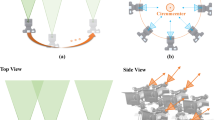Abstract
The progression in the field of stereoscopic imaging has resulted in impressive 3D videos. This technology is now used for commercial and entertainment purposes and sometimes even for medical applications. Currently, it is impossible to produce quality anaglyph video using a single camera under different moving and atmospheric conditions with the corresponding depth, local colour, and structural information. The proposed study challenges the previous researches by introducing single camera based method for anaglyph reconstruction and it mainly concentrates on human visual perception, where as the previous methods used dual camera, depth sensor, multi view, which demand not only long duration they also suffer from photometric distortion due to variation in angular alignment. This study also contributes clear individual image without any occlusion with another image. We use an approach based on human vision to determine the corresponding depth information. The source frames are shifted slightly in opposite directions as the distance between the pupils increases. We integrate the colour components of the shifted frames to generate contrasting colours for each one of the marginally shifted frames. The colour component images are then reconstructed as a cyclopean image. We show the results of our method by applying it to quickly varying video sequences and compare its performance to other existing methods.









Similar content being viewed by others
References
Anonymous Submission, 3D labeling stereo matching with content aware adaptive windows [LPU], 2016, The KITTI Vision Benchmark Suite, http://www.cvlibs.net/datasets/kitti/eval_scene_flow_detail.php?benchmark=stereo&result=935d4b884dd70d613a42468ec7abb624629ad256 Accessed 24 Aug 2016
Bhatti A, Nahavandi S (2008) Stereo correspondence estimation based on wavelets and multiwavelets analysis
Chen M, Bovik AC, Cormack LK (2011) Study on distortion conspicuity in stereoscopically viewed 3D images. pp. 24–29
Geiger D, Yuille A (1987) Stereopsis and eye movement. Proc.First Intl.conf on computer Vision. pp. 306–314, London,UK
Giribabu D, Kumar P, Mathew J, Sharma KP, Murthy YVNK (2013) DEM generation using Cartosat-1 stereo data : issues and complexities in Himalayan terrain. pp. 431–443
Han J, Shao L, Xu D, Shotton J (2013) Enhanced computer vision with microsoft kinect sensor: a review. IEEE Trans Cybernetics 43(5):1318–1334
Hartley RI. Theory and practice of projective rectification. no. 518
Hartley RI, Zisserman A (2004) Multiple view geometry in computer vision, edition.2. Cambridge University Press, ISBN: 0521540518
Hoshino M, Uesugi K, Pearson J, Sonobe T (2011) Research papers development of an X-ray real-time stereo imaging technique using synchrotron radiation research papers. no. 111, pp. 569–574
http://vision.middlebury.edu/stereo/data. Access 12 Aug 2016
Huang X, Yuan C, Zhang J (2015) Advances in multimedia information processing -- PCM 2015. 9315:14–23
Ideses I, Yaroslavsky L (2005) Three methods that improve the visual quality of colour anaglyphs. J Opt A Pure Appl Opt 7(12):755–762
Ideses I, Yaroslavsky LP, Fishbain B (2007) Real-time 2D to 3D video conversion. J Real-Time Image Proc 2(1):3–9
Kandrika S, Dwivedi RS (2013) Reclamative grouping of ravines using Cartosat-1 PAN Stereo Data. J Indian Soc Remote Sensing, Sci Vis 41(3):731–737
Konrad J, Member S, Lacotte B, Dubois E (2000) Cancellation of image crosstalk in time-sequential displays of stereoscopic video. 9(5):897–908
Ladický L, Sturgess P, Russell C, Clocksin W (2010) Joint optimisation for object class segmentation and dense stereo reconstruction. pp. 1–11
Li S, Ma L, Ngi Ngan K (2013) Anaglyph image generation by matching color appearance attributes. Signal Process Image Commun 28(6):597–607
Li X, Xu R, Zhou J, Li B (2007) Creating Stereoscopic ( 3D ) video from a 2D monocular. pp. 258–267
Loop C (2001) Computing rectifying homographies for stereo vision. 1:125–131
Matsuura F, Fujisawa N (2008) Anaglyph stereo visualization by the use of a single image and depth information. J Vis 11(1):79–86. doi:10.1007/BF03181917
Moretti S, Munir S (2015) Two Higgs bosons near 125 GeV in the complex NMSSM and the LHC Run-I data. p. 22
Nam KW, Park J (2012) Application of stereo-imaging technology to medical field. Healthc Inform Res. 18(3):158–163. In: Kim Y, Kim KG. doi:10.4258/hir.2012.8.3.158
Perazzi F, Kr P. Saliency filters : contrast based filtering for salient region detection
Pujari AK (1993) Volume intersection of shape and silhout. sadhana. 8(2):325–336
Raajan NR, Jaiseeli C et al (2012) Stereoscopic modelling of 3-D anagylph image. Computing, Electronics and Electrical Technologies (ICCEET). pp. 538–542
Ramos-diaz E, Kravchenko V, Ponomaryov V (2011) Efficient 2D to 3D video conversion implemented on DSP. pp. 1–9
Remote N (2015) S. Centre, and I. Space, Cartosat-1
Renga N, Kumar MR, Jaiseeli C, Monisha B. Stereoscopic Modelling of 3 -D Anagylph Image. pp. 538–542
Saxena A, Sun M, Ng AY. Learning 3-D scene structure from a single still image
Woods AJ, Rourke T (2004) Ghosting in anaglyphic stereoscopic images. 5291
www.nasa.gov/mission_pages/stereo/sun/index.html. Accessed 6 Mar 2015
Author information
Authors and Affiliations
Corresponding author
Rights and permissions
About this article
Cite this article
Raajan, N.R., Deepika, M.M. Human-vision-based real-time stereopsis. Multimed Tools Appl 76, 23481–23497 (2017). https://doi.org/10.1007/s11042-016-4120-9
Received:
Revised:
Accepted:
Published:
Issue Date:
DOI: https://doi.org/10.1007/s11042-016-4120-9




